| Home | Nature Weekly Index |
23 November 2014 | Field Trip | Mandai Area |
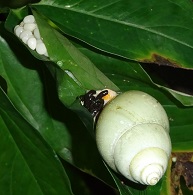
 After a few days of occasional downpour, it was a nice sunny morning last Saturday. I had an exciting trip to the Mandai area.
After a few days of occasional downpour, it was a nice sunny morning last Saturday. I had an exciting trip to the Mandai area.
The highlight of this trip was the sighting of the eggs of the Green Tree Snail (Amphidromus atricallosus). The nest of whitish eggs were wrapped around using the leaf from the Arrowhead Vine (Syngonium podophyllum). The snail, which I assumed had laid the eggs, were napping at the base of the "egg container" constructed with the leaf. The vine was up on a small tree while the location of the eggs were way above my height. Fortunately, it was not too high on the tree and the built-in zoom lens in my camera did its job well. Later, I did some search on the snail and realised that this might probably be the first time that the eggs of this snail was sighted in Singapore.
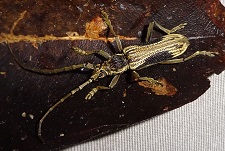 In fact, the exciting moments started from the beginning of the trip when I managed to capture some pictures of a longhorn beetle
that was new to me. It was resting on the surface of the leaf of a Leea Indica shrub
when I first spotted it. After sensing leaf movement cause by my manoeuvring of the leaf, it simply let itself dropped to the ground
like a rock. Surprising, it did not flew away but prefer to stay motionless, pretending to be dead. I had identified it as
Xoanodera trigona.
In fact, the exciting moments started from the beginning of the trip when I managed to capture some pictures of a longhorn beetle
that was new to me. It was resting on the surface of the leaf of a Leea Indica shrub
when I first spotted it. After sensing leaf movement cause by my manoeuvring of the leaf, it simply let itself dropped to the ground
like a rock. Surprising, it did not flew away but prefer to stay motionless, pretending to be dead. I had identified it as
Xoanodera trigona.
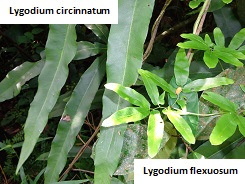 On the plant side, it was equally exciting. I came across a huge climbing fern, with the usual feature of such fern except for the
size of its fronds (leaves). At first, I thought that it was
Lygodium longifolium. Later, I realised that it had to be
Lygodium circinnatum. All the Lygodium circinnatum that I had seen
before this trip were wrongly named as Lygodium circinnatum. According to the
Flora of China website, Lygodium longifolium
has a serrulate pinnae margin (translated as fine teeth along the margin of the leaves) while that of Lygodium circinnatum is
smooth (no teeth). Based on the description, I should have the name right this time round. I was so glad that this confusion of mine
was finally resolved by this sighting of the real Lygodium circinnatum.
On the plant side, it was equally exciting. I came across a huge climbing fern, with the usual feature of such fern except for the
size of its fronds (leaves). At first, I thought that it was
Lygodium longifolium. Later, I realised that it had to be
Lygodium circinnatum. All the Lygodium circinnatum that I had seen
before this trip were wrongly named as Lygodium circinnatum. According to the
Flora of China website, Lygodium longifolium
has a serrulate pinnae margin (translated as fine teeth along the margin of the leaves) while that of Lygodium circinnatum is
smooth (no teeth). Based on the description, I should have the name right this time round. I was so glad that this confusion of mine
was finally resolved by this sighting of the real Lygodium circinnatum.
The size of Lygodium circinnatum can be easily visualised when compare to the smaller Lygodium flexuosum, that happened to grow in the same location.
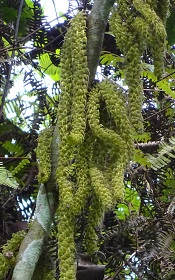
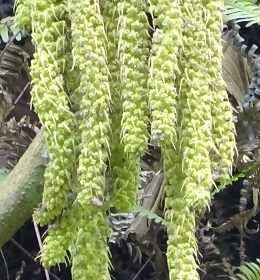 At one point from a far distance, I saw these yellowish hanging object that appeared to originate from a woody climber. The woody
climber was up on a tall tree. Due to the distance the height, I can only vaguely see the feature of these object, which I suspected
to be the flowering buds of the woody climber. It should be
Phytocrene bracteata.
At one point from a far distance, I saw these yellowish hanging object that appeared to originate from a woody climber. The woody
climber was up on a tall tree. Due to the distance the height, I can only vaguely see the feature of these object, which I suspected
to be the flowering buds of the woody climber. It should be
Phytocrene bracteata.
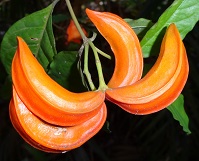 Besides Lygodium circinnatum, the other new plant that I added to my website from this outing was
Tabernaemontana pauciflora. The shrub was by the side of a track and
was full of the hanging bright orange fruits, making it hard to miss.
Besides Lygodium circinnatum, the other new plant that I added to my website from this outing was
Tabernaemontana pauciflora. The shrub was by the side of a track and
was full of the hanging bright orange fruits, making it hard to miss.
On top of all these exciting discoveries, I managed to add some new pictures of existing plants in my website: Fruits of Polyalthia angustissima and Glochidion obscurum; flower bud of Uncaria cordata.